
A Cave of Candles / by Dorothy V. Corson

Chapter 17
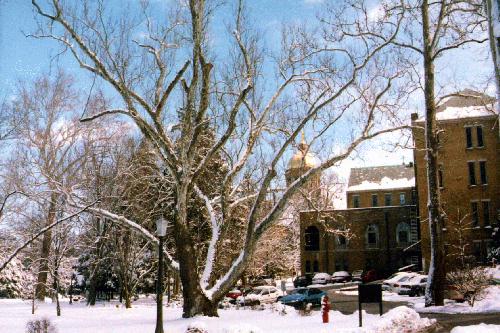
A Curse on Our Lady's Lakes?
Invigorated by my last unexpected finds, most especially, the written description of the St. Mary's 1874 Grotto and Seaton's "The Song of Bernadette" script, I continued to pour over whatever remained of any other sources I might have missed the first time around. I had not long to wait for more items of particular interest to surface. One line of text concerning the school colors came first, then an "Interesting Story About A Sycamore Tree."
In searching through folders in the University Archives connected with the Sacred Heart Church, earlier, I had found the copy of the story about "The Forgotten Crown." This time, in browsing randomly through the Scholastic index, I found a card with a typed line that immediately caught my attention: "Interesting Story About A Sycamore Tree." The card stated it was in the November 16, 1934 issue. I found nothing there. Obviously, someone indexing it had made an error in recording the date. I went backwards and forwards finding nothing. I was about to give up when I finally found it, on a different date. A one column story entitled, "Legendary Tree Stands In Rear of Corby Hall."(194) No author was noted.
I wasn't far into the story when I knew it had to be the tree Father Cavanaugh told me about the same day he told me about the missing Empress Eugenie Crown. He described the tree and where it was located on campus and said it looked like a hand outstretched in a pleading gesture. The story could have been written by Father Cavanaugh himself, or told by him, it was so close to my recollection of it. In 1934, Rev. John J. Cavanaugh, C.S.C., later president of Notre Dame, would have been a newly ordained priest. He returned from his studies in Rome in 1933 to teach at Notre Dame and replace Father John O'Hara as student chaplain.
I have been told by seasoned researchers that it is in the nature of a meandering search for clues to run into fortuitous circumstances. Are they causal connections -- these unforeseen happenstance meetings with persons or things at opportune moments -- or a progression of effects that position themselves in our lives at just the right moment to be useful to a mind prepared to receive them?
Whatever the explanation, I was learning how interesting life can become when we follow those intuitive impulses. Reminiscing about some of those inspirational moments brought to mind another longtime campus friend, Brother Chester Ziemba, C.S.C., a St. Francis to all the wildlife he feeds at Notre Dame. I met him at the Fatima Retreat Mission House on St. Mary's Lake where Father Jan lived when I first visited him. Father Jan had set up a nursery there in a tiny abandoned washroom where he incubated and raised quail in hopes that he could populate the campus with them. This was before his heart attack when he was sent to Holy Cross House.
After he was transferred, I would stop every now and then to visit Brother Chet at Fatima. He would take a break from his groundskeeping and we'd sit on a bench near the water's edge, feeding the ducks, and talking about those creative impulses and significant coincidences that pop up in life when we least expect them. He referred to them as "Impulses of Grace," the guidance of the Holy Spirit when a soul on earth does not resist them, and he would quote St. Therese of Lisieux: "Be like a leaf in the wind."
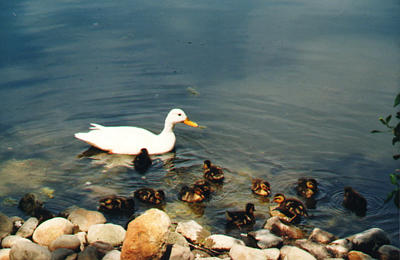
He then explained the analogy. "St. Therese, The Little Flower, pictured herself like a leaf falling from a tree and the leaf goes wherever the wind blows it. A leaf doesn't resist the wind nor should a soul resist the inspirations of the Holy Spirit -- those impulses of grace. Let life blow you, like a leaf, wherever it will." It was his way of encouraging me to listen to my heart and follow it wherever it might lead me. I could not have imagined, at the time, that 25 years later, "being like a leaf in the wind" would plant me on a path that would lead me to researching the story behind the Grotto. Nor would I have been able to guess where that research was going to lead me next.
I was musing about the curious coincidence of finding evidence of yet another story Father Cavanaugh had told me, when Peter Lysy passed my way and I showed him the article about the sycamore. He skimmed it, nodded an acknowledgment of another of my finds without much comment, and disappeared into the archival storage rooms. Nearing the end of my day's work at the archives, I made up my mind to wait until the next day to decide whether it was worthy of pursuing further. I left soon afterward.
The next day, to my surprise, Peter greeted me with an old worn scrapbook from the 1930s and 40s(195) filled with yellowed newspaper articles about Notre Dame. He said it came to his mind after I showed him the Scholastic article about the tree the day before. He remembered seeing something about it when he was processing the old scrapbook some time ago. He went back to the storage room to hunt it up, but I had left before he returned. He paged through the scrapbook and pointed to the article about the sycamore.
It was another very similar adaptation of the same story. This rendition alluded to the spirit of the wronged Indian entering the tree and included an added twist. There was a picture of the tree with the heading, "Sign of Indian Curse?" With the added sub-heading: "Hand-Shaped Tree Whispers Legend . . . ." It was the same oddly shaped tree Father Cavanaugh had referred to as The Superstition Tree. He said it was also called the Vengeance Tree.
At the end of the 1930s newspaper article was a teaser sentence that piqued my curiosity:
Perhaps the tale is linked with another Indian curse -- that the lakes every year will take their toll of one human life. Until a few years ago with noteworthy regularity this prophecy was fulfilled.
I had previously run across a reference to "the tale of the ghost that rides by the lake" in a list of Notre Dame traditions in a 1926 Dome and wondered about it then. To have become a tradition it had to have been handed down by word of mouth or by practice over a period of time. Later, in paging through old Scholastics, I found a reference to it again in an 1874 entry:
What mean those hand-saw tones of 'now,' 'now,' 'now,' which come to our ears on an evening from over the waters of the lower lake [St. Mary's]. Can it be that the lonely spirit of some poor departed hero is loitering around that romantic region?(196)
Could there be a connection here? Could the "curse," the "ghost," and the "legend" be related to one another? Were they linked somehow with the deaths in the lakes, the wronged Indian and the legendary sycamore on the Grotto lawn? It was just one more of those bits and pieces of information I couldn't let go unchallenged. I'd already located the drownings in the lake in checking out the Kowalski story about the deaths while the Grotto was being built. It didn't seem much of a task to see for myself if there had been a death a year in the lakes up to 1932. The happenstance way it came into my hands reinforced my inclination to pursue this supposed "curse" wherever it might lead me. It was to "blow me like a leaf in the wind" in the direction of the public library microfilm machines to see if I could confirm or deny this latest bit of campus lore.
Another item of interest concerning the school colors also required a trip to the public library. Being the less ambitious project I decided to begin with it.
Mary and the School Colors
In an 1890s folder in the University Archives which contained descriptions of the University from earliest times, I found this second interesting item from an article written by Lelia P. Roby in 1891.
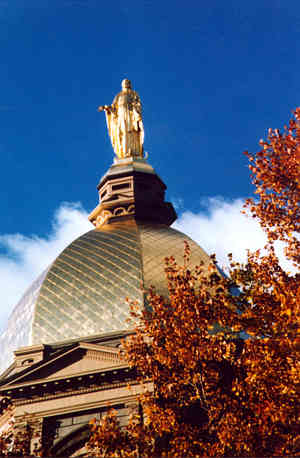
It is interesting to know that the college colors are yellow and blue; in heraldry, yellow is light and blue is truth.(197)
The extent of the University's devotion to Mary hadn't fully registered on me until I also read these words in an 1896 Annals:
Notre Dame the Home of the "Ave Maria," Notre Dame the home of Mary to whom all the grounds are dedicated, to whom all the buildings are dedicated, to whom is given all the credit of the work done here for the past fifty years. Mary is sole superior at Notre Dame.(198)
The Ave Maria put it even more succinctly: "Every inch of its ground was consecrated to Mary.
It hadn't occurred to me before, that even the school colors for both campuses were chosen to honor Mary.
I've never seen this reference to the significance of the symbolism of the school colors in any other printed source before or since. I had a feeling at the time that it might factor into my later research so I set it aside and decided to wonder about it later. Now seemed as good a time as any to check it out. A reference book on symbolism at the St. Joseph County Public Library revealed more interesting information on the subject. A call to Saint Mary's revealed that their colors were the traditional ones associated with Our Lady -- sky blue and white. It was evident that all aspects of both campuses were related to Marian devotion and the inspiration to be derived from her heavenly protection.
When I inquired about the school colors at the archives on both campuses, I was surprised to learn little was known about their meaning, other than the obvious, that Our Lady's colors were blue and white. Their original symbolism was apparently lost in history along with this early 1890s reference to the school colors. Following is the information I found regarding the school colors chosen to represent Notre Dame and Saint Mary's. It is interesting to note that all the attributes listed with these colors are also associated with Mary:
BLUE Truth; the Intellect; revelation; wisdom; loyalty; fidelity; constancy; chastity, chaste affections; spotless reputation; magnanimity; prudence; piety; peace; contemplation; coolness. . . . Christian: Heaven; heavenly truth; eternity; faith; fidelity; the colour of the Virgin Mary as Queen of Heaven.
GOLD -- The sun; divine power; the splendour of enlightenment; immortality. . . .
WHITE . . . White is associated with both life and love, death and burial. In marriage it symbolizes death to the old life and birth to the new, while in death it represents birth into the new life beyond. . . . The purified soul; joy; purity; virginity, innocence; the holy life; light; integrity.
YELLOW Christian: As golden sacredness; divinity; revealed truth; 'the robe of glory'; used for feasts of Confessors.(199)
Notre Dame's Blue and Yellow (or gold), its Golden Dome, and Saint Mary's Blue and White are emblematic of everything Our Lady represents. Sometime, undoubtedly after the Dome and Statue were gilded, Notre Dame's colors, Blue and Yellow, must have become Blue and Gold. The first evidence of this turned up in an account of a pilgrimage to the Grotto in 1896 and the badges that were worn. "The badge was a circle with a picture of the Grotto, suspended from a blue and gold ribbon hanging from a gilt bar. It was pretty."
Later information obtained while editing this portion of my manuscript has clarified the origin of the school colors. Three old copies of The Tower yearbook from St. Edward's University were given to me by a neighbor to leave with the archives. In perusing them before turning them over, I chanced upon more information about the school colors that was new to me. I knew that St. Edward's University had been founded by the Holy Cross order but I was not aware that it was established while Father Sorin was still alive and founded by him. It also explains why St. Edward’s Day was always a special celebration at Notre Dame during Father Sorin’s lifetime.
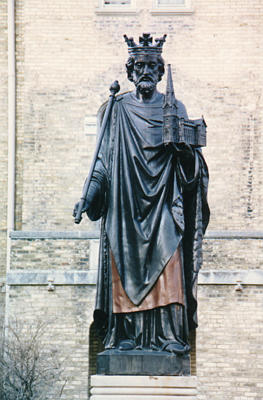
Under the heading "St. Edward's, King and Confessor" was this item of special interest about the school colors:
We recognize Saint Edward, King and Confessor, during the celebration of the 900th anniversary of the foundation of Westminster Abbey by our patron saint on Holy Innocents' Day, 1065. Father Edward Sorin, founder of Notre Dame and St. Edward's Universities, held King Edward as his patron saint. Blue and gold, the royal colors of the king, are the colors held dear by the two educational institutions. The death of Saint Edward is commemorated on October 13, his feast day. This day has been celebrated at Saint Edward's University since the founding of our university in 1881, Austin, Texas.
In the midst of combing the Hesburgh Library stacks for more information about St. Edward, I made a startling discovery. A very bizarre story written about St. Edward the Confessor in 1688. Just touching a book written by someone in 1688 -- hidden away in the library stacks -- amazed me. I wondered how long it had been there without anyone laying a finger on it. The title covered the whole 5" x 7" front cover and read:
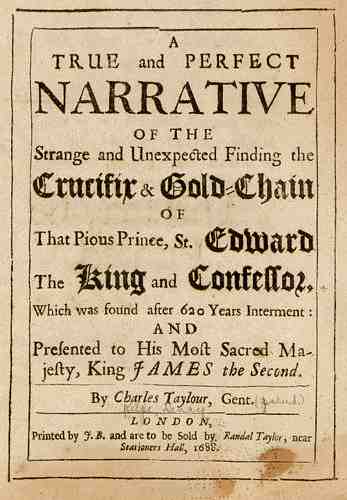
The ancient abbey and its history held a fascination for him. In
observing renovations in the St. Edward's Chapel at Westminster, after
the workmen had left, he climbed a ladder to get a closer look at St.
Edward's tomb and noticed a hole in the top of it. Curious he reached into
the hole and his fingers entwined around something inside. He
carefully lifted it out to find it was the crucifix and Gold Chain of
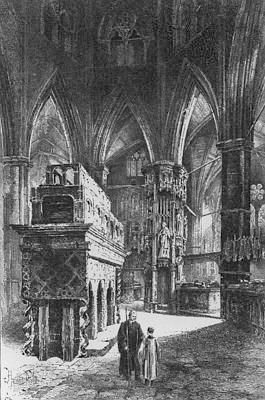 St. Edward the Confessor. As one can imagine he pondered what to do
next. If he put it back a curious workman might find it as he did and
spirit it away. He decided to keep it safe from harm himself until he
found someone in authority to pass it on to. His narrative relates his
adventure in seeing it safely into the hands of King James himself.
It’s a delightful story of an ordinary townsman finding himself, by
chance circumstances, in the august presence of the King of England.
St. Edward the Confessor. As one can imagine he pondered what to do
next. If he put it back a curious workman might find it as he did and
spirit it away. He decided to keep it safe from harm himself until he
found someone in authority to pass it on to. His narrative relates his
adventure in seeing it safely into the hands of King James himself.
It’s a delightful story of an ordinary townsman finding himself, by
chance circumstances, in the august presence of the King of England.
I immediately put this precious document into the hands of the Hesburgh Library Rare Books & Special Collections for safekeeping, whereby I learned it is one of only three copies in the world -- one in London, one at Harvard, and one at Notre Dame. And it is there today for anyone interested to see for themselves. They made photocopies of the book for me in appreciation for seeing it into their hands. These copies are now with my research materials in the archives. Again by curious coincidence a link with the past had been forged and in so doing a little known aspect of Notre Dame's history had come to light. The university's Blue and Gold colors were not only associated with Mary, the Queen of Heaven, Father Sorin's "guiding star," they were also the royal colors of King Edward, St. Edward, the Confessor, the patron saint of Father Edward Sorin -- founder of Notre Dame and St. Edward's University. Father McAvoy said it so well: "To have a history is to have a name and the richer the history the more glorious the name."
Earlier I found myself absorbed in the symbolism of stone and its application to the Grotto. Now I found the symbolism of color equally applicable. As the yellow flame on a lighted candle -- like hands folded in prayer -- is a symbol of hope, Mary is the ultimate symbol of faith and fidelity. Our lives, much more than we are aware of, are ordered by unconscious symbols that affect us subliminally, for good or ill, depending upon our personal perception of them. An interesting phenomenon to ponder, the tangible and intangible images stored away in our minds that have the power to spur us on, often against seemingly impossible odds.
A recent article in our local newspaper illustrates how our lives can be guided and sustained by symbolic inspirations. The news article reported:
The estate of Mary Frances McNamara gave $1.2 million to establish the McNamara Scholarship Fund in the Notre Dame Law School. A Chicago Public Schools teacher who died last year at age 99, McNamara wrote in her last will and testament, 'Through my lifelong devotion to Mary Our Mother, I have been blessed with a long productive and happy life. . . . In thanksgiving, I bequeath all of the rest, residue and remainder of my estate . . . to her university, the University of Notre Dame du Lac . . . for the purpose of establishing more funded scholarships in the Law School."(200)
By now, I had become accustomed to the discovery of unusual archival finds in unexpected places. I decided to page through the remaining two Tower yearbooks before passing them on -- surprised to find in the next book a picture of a grotto at St. Edward's. Curious, I decided to learn more about it. The material their archivist sent to me contained not only another of those long forgotten pieces of history but yet another item of interest the two universities shared in common.
The St. Edward's Lourdes Grotto was designed and built in 1930-1933 by another Notre Dame legend, Fr. Bernard Lange, C.S.C., while he was at St. Edward's earning an advance degree. He was assisted by James Farraghar, a former Notre Dame grid star who was working at St. Edward's at the time. They labored together over a span of two years to complete it. Fr. Lange was transferred back to Notre Dame, shortly after it was finished. It was not landscaped and accessorized until its dedication in 1939.
Except for his brief stay at St. Edward's, Fr. Lange spent almost his entire lifetime at Notre Dame. Yet I found nothing in sources on the Notre Dame campus about St. Edward's Grotto among the many stories written about Fr. Lange. He was a multi-talented man whose colorful personality, and feats of daring bordered on the unbelievable. He was holder of the title of the fourth strongest man in the world. As a young man he climbed to the top of the Dome, perched on Our Lady's shoulder, put his arm around her neck, and waved to his classmates below. And as he put it, he almost got kicked out of school. He would grease his body and swim in the icy waters of St. Mary's Lake in the wintertime. His body building gym for Notre Dame boys and the stories told about him are legend. And once again, another coincidence, Fr. Lange, and the benefactor of the Notre Dame Grotto, Fr. Thomas Carroll, both came from Oil City, PA. Could the Notre Dame Grotto and its benefactor being from his hometown have inspired him to build the one at St. Edward's, or was it a mere coincidence?
When I received the information about their Grotto from the archivist, Ingrid Karklins, as fate would have it, our son was living and working in Austin for a brief time. And thereby I discovered another little piece of history associated with Sorin and another historic tree. On our one and only visit to see our son before he moved on, he took me to see the St. Edward's Grotto, which is nestled in a little cliff below the Main Building on the highly elevated campus overlooking the city of Austin. As we climbed back up the high hill leading to a roadway above the Grotto, a burst of color flew past us from a bush nearby. It looked like a tropical bird loose from its cage. Intrigued, we both scurried after it just in time to see it land briefly in a huge live oak tree near the Main Building. When it flew away, I began admiring the impressive tree before us, my eyes drawn to a plaque beneath it. Written on it were the words, "Sorin's Tree."
To my wonderment a colorful bird on the wing had led us to that very tree and another interesting piece of history. A call to the archivist solved two mysteries. She said the colorful bird was a Monk parrot, that many had migrated from South America and made their home in Austin. She also supplied additional information I hadn't run across before. When Sorin founded St. Edward's University in Austin, Texas, he expressed the wish that it would become the "Notre Dame of the South." The tree I saw was called Sorin's Tree because he chose the site for its hilltop view and the huge live oak growing there. It also became known as the "Umbrella Tree" and the "Lone Tree" because it was the only tree on the spot at the time.
Learning more about Sorin and the St. Edward's University proved to be another of those interesting unplanned detours I would never have expected to take and it provided more tidbits of information that were just too tempting and out-of-the-ordinary to resist. The image of a curse on Our Lady's lakes -- and the prospect of learning more about Notre Dame's landmark tree -- was more than enough to spur me on.
The name chosen for the University, Notre Dame du Lac (Our Lady of the Lake) spoke for itself. Even the island in the original "one" lake, until it became two, was known as St. Mary's Island. Since both campuses and everything on them -- buildings, grounds, the lake, the Grotto, the Ave Maria magazine and the school colors -- were dedicated to the Blessed Virgin, a so-called "curse on the lakes," was one more item of history associated with Our Lady I had to put to rest. Was a legend connected with the historic sycamore fact or fantasy, and was it true that for a period of time there had been a yearly death in the Lakes?
Researching the Indian Curse
In contemplating my next venture -- studying the Indians in the area -- I wondered where the powers that be would be leading me now and whether I'd have the energy and resources to keep up with them. I reached for a bookmark to place at the next chapter in the library history book I was reading, and discovered there was already a small bookmark there, left by a previous reader. At the bottom, was the name of the order it had come from. I turned it over and to my surprise received just the encouragement I needed to keep going:
In the eyes of God, what a great and beautiful work it is to accomplish little things with fidelity and perseverance.
Energized by this welcome bit of encouragement, I decided to tackle the curse first, tracing the drownings in St. Joseph and St. Mary's lakes to see if there really had been one a year. Once that was established one way or another, then I'd concentrate on the authenticity of the Indian legend and the Vengeance Tree. Both required a study of the Indians, mostly Potawatomi and Miami, living in upper Indiana near the time Notre Dame was founded.
During the day I was hunting through old newspapers on microfilm at the public library. Evenings I poured over any books at Notre Dame and local libraries that I could find on Indians. Though I had lived in South Bend all my life and near Notre Dame more than half of it, I was just beginning to realize, how little I knew about the history of Indiana.
The name of a member of the Potawatomi tribe, living in Berrien County, was given to me to contact by another friend at Rare Books and Special Collections, Christian Dupont. He explained that all Indian history was passed on orally in stories and legends and that it might save time to check it out with a member of the tribe first, to see if this Indian legend or the curse on the lakes was known to them. He gave me a number in Cassopolis to call. The man I spoke to, had a daughter who graduated from Notre Dame and another attending there. He said he was going to a tribal council meeting the following week and assured me that if I sent a copy of the legend to him he would present it to the council. A return call from him several days later produced no confirmation -- none of the elders at the tribal council had heard of the legend or the curse. With no other alternatives, it looked like my next step would have to be a trip to the St. Joseph County Library to look for more evidence of drownings in the lakes.
A Murder Mystery?
An afternoon spent at the microfilm machines checking the front pages of newspapers for more drownings soon dampened my enthusiasm for such a time consuming search. I'd forgotten how long I'd spent hunting up the "two or three deaths" related to the Grotto. I felt there had to be a better way to tackle that kind of project in a more systematic fashion.
However, sorting through several years of front page news had not been without its surprises. Just as I was about to look for a better approach to my latest mission, I happened upon a rather shocking unsolved mystery associated with the riverbank near the glen at St. Mary's. According to the newspaper article the crime had excited countrywide interest in early 1927. Because it was sensationalized and rather gruesome, it seemed inappropriate to include it. I took copies of it for later perusal and set it aside.
I decided to check one more year or so of newspapers and then move on. A year and a half later, I found another reference made to this, by now, famous unsolved mystery. It referred to a forthcoming fact-based fictionalized story being written about it, in serial form, for the South Bend Tribune. I found it later under the heading "Mystery Killing to be Theme of Story." I skimmed the weekly story and discovered that it was centered around South Bend, Notre Dame and St. Mary's even to using fictional students from Notre Dame in the storyline. Again, I hesitated, questioning whether to include it, until I realized that in excluding it I would be editing history.
I was there to investigate campus history, and the setting of this unfortunate homicide, like the reputed Indian legend, was on campus ground, this time at St. Mary's. The date on the top of the newspaper convinced me. It seemed marked to be recorded. The South Bend Tribune headline article was dated, February 11, 1927, Lourdes Day. The coincidence itself, was nudge enough for me to include it, especially, since it concerned the nearby area in which I had found the remains of the 1937 Grotto and St. Angela's Island.
I reviewed the first article I had found. The headline in the paper read:
'OPEN GRAVE' IS DISCOVERED. THINK SLAYER DISINTERRED WOMAN'S BODY. Police Sergeant makes discovery near St. Mary's. Part of Body Found May Never Have Entered Water. Discovery this afternoon of a square hole dug in the ground about 300 yards from the place where the partial body of a woman was found on a bank of the St. Joseph river near St. Mary's college, yesterday, has set police working on a new theory to substantiate their belief that a murder had been committed. The body was found by hunters strolling along the riverbank.
It was felt that the disappearance of a woman, who had boarding at her home a man who was employed at St. Mary's as a handyman, who disappeared at the about the same time, might have a bearing on the case. She was a married woman and was said to have had an argument with this man when he wanted her to leave her children and run away with him. Man-made caves were investigated on the banks of the St. Joseph River adjacent to St. Mary's college in an effort to find the rest of the body.
The search was instituted in conformance with the scientific revelations of the city chemist that the white substance on the body was marl similar to that found in the vicinity.
This was apparently the same marl used to make the bricks for the early buildings on campus. The investigation ran its course over the next several days and then all news of it disappeared from the paper. I wondered if either of the two people thought to be involved were ever found.
In the second South Bend Tribune article regarding the upcoming story, which appeared almost a year and a half later, on page 2 of the July 11, 1928 issue, I received a partial answer. It relates:
The torso murder, as it was called at the time of its discovery, occupies a prominent place in the unsolved crimes of the middle west. It received headlines in papers throughout the country and attracted star reporters to South Bend from all the leading newspapers of this section. Reporters from some of the greatest papers of the middle west pronounced the case one of the greatest mysteries they had ever encountered. The body was finally buried in a local potter's field here. Officials called the case a mystery and most of the world forgot about it.
One more grave site deserving a tombstone labeled, "Known Only To God."
It was noted that eighteen months had passed and the identity of the dead woman and the manner in which she met death remained a mystery. All these things, a local author had woven into a mystery story which was later published in the paper. The South Bend Tribune also offered a cash prize for a suitable title. Notre Dame and its students were also woven into the story. Trips to the murder site at St. Mary's followed with the fictional killer eventually being caught at the scene of the crime.
It sounded like something out of Hollywood, yet there it was in black and white. One more real happening associated with the campuses. One could begin to see how bits and pieces of fact-based stories could become legends associated with places over a period of time. Only in this case, I had evidence to prove this one actually happened. I had referred to the "Ghost of the Grotto in the Glen," in describing what remained of it, unaware of the ghostly memories of a dastardly deed that haunted the riverbank in a nearby area.
Some time after this part of my research was completed, I happened to mention it to an 84 year old woman I had contacted on an unrelated area of my research and she surprised me with a remembrance of it. She said she was seventeen at the time and she never forgot it because it was such an baffling unsolved mystery. However, none of the elderly religious on either campus had ever heard of it. Possibly because any religious still living would likely have been cloistered novices at the time.
As late as 1908, Sister Madeleva mentions in her autobiography:
One afternoon Sister (Rita) and I walked on the river bank and talked of the religious life.(201)
The beautifully landscaped riverbank and its river walks were also shown in a 1905 photograph mentioned earlier. I wondered if this unfortunate event might have had something to do with the nearby glen area ultimately being abandoned.
Unwittingly, I had discovered a later parallel to the wronged Indian and the Legend of the Sycamore at Notre Dame. This one, near St. Mary's, was now long forgotten, buried in the past -- there was no legend or even a ghost story attached to it. Nonetheless, it was a true story and I had the evidence to prove it. Would I also be able to find evidence to prove or disprove the "curse" and the "legend" as well? I took copies of the news articles, to document the story, and went on looking for an easier way to find any drownings in the lakes that might apply to the "Indian Curse" little realizing that I was about to run across the coroner's record of this mysterious 1920s unsolved mystery.